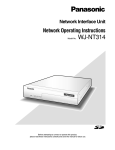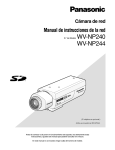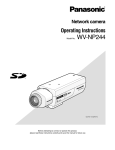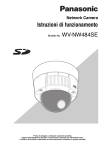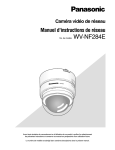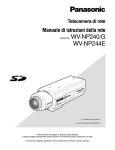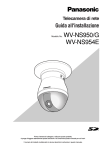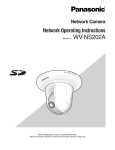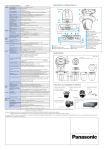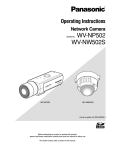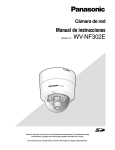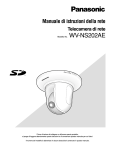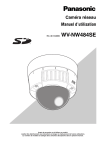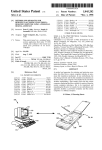Download Network Operating Instructions
Transcript
Network Camera
Network Operating Instructions
Model No.
DO
INS
ME
ER
T
WV-NF284
DO
ME
CO
WV-NF284
V
AD ER
JU
ST
LO
CK
CO
VE
R
Before attempting to connect or operate this product,
please read these instructions carefully and save this manual for future use.
No model number suffix is shown in this manual.
CONTENTS
Preface ............................................................................................................................ 3
About these operating instructions .............................................................................. 3
Trademarks and Registered Trademarks ................................................................... 3
Viewer Software .......................................................................................................... 3
Monitor Images on a PC .................................................................................................. 4
Monitor images from a single camera ......................................................................... 4
Monitor images from multiple cameras ....................................................................... 7
Action at an Alarm Occurrence ....................................................................................... 8
Transmit Images onto an FTP Server ............................................................................. 9
Transmit an alarm image at an alarm occurrence
(Alarm image FTP transmission) ................................................................................. 9
Transmit images at a designated interval or period (FTP periodic transmission) ....... 9
Save images on the SD memory card when failed to transmit images by the
FTP periodic transmission function ............................................................................. 10
About the network security of this unit ............................................................................. 12
Equipped security functions ........................................................................................ 12
Display the Setup Menu and Configure the Settings of the Camera using a PC ............ 13
How to display the setup menu ................................................................................... 13
How to operate the setup menu .................................................................................. 14
Configure the basic settings of the camera [Basic setup] ........................................... 17
Configure the settings relating to images and audio [Camera setup] ......................... 21
Configure the multi-screen settings [Multi-screen setup] ............................................ 26
Configure the alarm settings [Alarm setup] ................................................................. 27
Configure the settings relating to the authentication [Authentication setup] ............... 34
Configure the settings of the servers [Server setup] ................................................... 36
Configuring the network settings [Network setup] ....................................................... 38
Maintenance of the camera [Maintenance] ................................................................. 46
About the Displayed System Log .................................................................................... 49
Troubleshooting ............................................................................................................... 51
2
Preface
About these operating instructions
There are 2 sets of operating instructions for the WV-NF284 as follows.
• Installation Guide
• Network operating instructions
These network operating instructions contain descriptions of how to operate this product using a PC via a network
and of how to configure the settings.
Refer to the installation guide for descriptions of how to install this product and of how to connect to a network.
Adobe® Reader is required to read PDF. When the Adobe® Reader is not installed on the PC, download the latest
Adobe® Reader from the Adobe web site and install it.
Trademarks and Registered Trademarks
• Microsoft, Windows, Internet Explorer, ActiveX and DirectX are either registered trademarks or trademarks of
Microsoft Corporation in the United States and/or other countries.
• Adobe and Reader are either registered trademarks or trademarks of Adobe Systems Incorporated in the United
States and/or other countries.
• SD logo is a trademark.
• Other names of companies and product contained in these operating instructions may be trademarks or registered trademarks of their respective owners.
Viewer Software
• Images will not be displayed when the viewer software "Network camera View3" is not installed on the PC. Install
the viewer software from the provided CD-ROM.
• The viewer software used on each PC should be licensed individually. Refer to your dealer for the software
licensing.
3
Monitor Images on a PC
The following are descriptions of how to monitor images from the camera on a PC.
Monitor images from a single camera
Step 1
Start up the web browser.
Step 2
Enter the IP address designated using the Panasonic IP
setup software in the address box of the browser.
Example: http://192.168.0.10/
Important:
• When the HTTP port number is changed from "80",
enter "http://IP address of the camera +: (colon) +
port number" in the address box of the browser, for
example, "http://192.168.0.11:8080".
• Configure the web browser to not use the proxy
server.
Step 3
Press the [Enter] key on the keyboard.
→ The "Live" page will be displayed.
4
Notes:
• When "ON" is selected for "User Authentication"
(☞ page 34), the authentication window will be displayed before displaying live images for the user
name and password entries. The default user name
and password are as follows.
User name: admin
Password: 12345
When accessing the camera without changing the
default password, the pop-up window saying that it
is recommended to change the password will be displayed.
To enhance the security, change the password for
the user "admin". It is recommended to change this
password periodically.
• Maximum concurrent access to the camera will be
limited to up to 8 users in the following case.
• When "Unicast port (AUTO)" is selected for
"Transmission type" (☞ page 22)
• When "Unicast port (MANUAL)" is selected for
"Transmission type" (☞ page 22)
• When JPEG images are being transmitted from
the camera
Depending on the set values for "Total bit rate" and
"Max bit rate (per 1 client)", the maximum concurrent
access number may be less than 8 users. When 8
users have been concurrently accessing already, the
access limit message will be displayed for users who
accessed subsequently.
• When "ON" is selected for "MPEG-4 transmission"
(☞ page 22), an MPEG-4 image will be displayed.
When "OFF" is selected, a JPEG image will be displayed. It is possible to display JPEG image even
when "ON" is selected for "MPEG-4 transmission".
In this case, the refresh interval will be limited.
<Refresh interval (JPEG)>
• When "ON" is selected for "MPEG-4 transmission"
JPEG (VGA): 5 fps
JPEG (QVGA): 10 fps
• When "OFF" is selected for "MPEG-4 transmission"
JPEG (VGA or QVGA): 30 fps
The refresh interval may be longer depending on a network environment, PC spec, photographic subject,
access traffic, etc.
Important:
• When displaying multiple MPEG-4 images on a PC,
images may not be displayed depending on the performance of the PC.
• When "ON" is selected for "VMD alarm" (☞ page
27), the frame rate of MPEG-4 images will become
15 fps at a maximum.
Refer to this page for further information about the
"Live" page.
About the "Live" page
!0 Alarm occurrence indication button
!1 Full screen button
o Camera name
!2 One shot button
!3 Audio button
q [Setup] button
w [Live] button
!4 Time and date
e Multi-screen buttons
r Image type buttons
t Image capture size buttons
y ZOOM buttons
u Brightness buttons
!5 Main area
i AUX buttons
q
[Setup] button (*1)
Click this button to display the setup menu. The button will turn green and the setup menu will be displayed.
w
[Live] button
Click this button to display the "Live" page. The button will turn green and the "Live" page will be displayed.
e
Multi-screen buttons
Images from multiple cameras can be displayed on
a multi-screen by registering cameras on the setup
menu. (☞ page 7)
r Image type buttons
: The letters "MPEG-4" on the button will
turn green and an MPEG-4 image will be
displayed. When "OFF" is selected for
"MPEG-4 transmission" on the setup
menu, the [MPEG-4] button will not be displayed. (☞ page 22)
: The letters "JPEG" on the button will turn
green and JPEG image will be displayed.
5
t Image capture size buttons
These buttons will be displayed only when a JPEG
image is displayed.
: The letters "VGA" on the button will turn
green and images will be displayed in VGA
size.
: The letters "QVGA" on the button will turn
green and images will be displayed in
QVGA size.
y ZOOM buttons (*2)
: The zoomed image will be zoomed out.
(Image displayed in the original size cannot be
zoomed out.)
: The zoomed image will return to the original
size.
: The displayed image will be zoomed in.
Note:
When "ON" is selected for "VMD alarm" (☞ page
27), the displayed images will not be zoomed in.
u Brightness buttons (*2)
: The displayed image will be darker.
: The adjusted brightness will return to the
default brightness. (☞ page 24)
: The displayed image will be brighter.
i AUX buttons (*2)
: The AUX connector will open.
: The AUX connector will close.
o Camera name
The set camera name will be displayed.
6
!0
Alarm occurrence indication button (*2)
This button will be displayed and will blink when an
alarm occurred. When the button is clicked, the button will disappear and the alarm output connector
will be reset. (☞ page 29)
!1
Full screen button
Images will be displayed on a full screen. To return
to the "Live" page, press the [Esc] key or the [F5]
key, or the combination of the [Alt] key and the [F4]
key on the keyboard.
!2
One shot button
Click this button to take a picture (a still picture). The
picture will be displayed on a newly opened window.
When right-clicking on the displayed image, the popup menu will be displayed. The displayed image can
be saved on the PC by selecting "Save" from the
pop-up menu.
!3
Audio button
The [Audio] button will be displayed only when "ON"
is selected for "Mic mode" on the setup menu.
(☞ page 25)
When this button is clicked, the button will turn into
the
button and audio will not be heard.
!4 Time and date
Current time will be displayed in the set date/time
display format (☞ page 17).
!5 Main area
Images from the camera will be displayed in this
area.
*1 Operable by only users whose access level is "1.
Administrator"
*2 Only operable by users whose access level is "1.
Administrator" or "2. Camera control" when "ON" is
selected for "User authentication" (☞ page 34).
Refer to page 34 for further information about the
access level.
Monitor images from multiple cameras
Images from multiple cameras can be displayed on a multi-screen. Images from up to 4 cameras can be displayed
simultaneously. To display images on a multi-screen, it is necessary to register cameras in advance. 4 cameras can
be registered as a group and up to 2 groups (8 cameras) can be registered. (☞ page 26)
Important:
• Select "OFF" for both the user authentication and the host authentication of the camera to be registered.
(☞ pages 34 and 35)
• Only JPEG images can be displayed on a multi-screen. Audio will not be heard.
• When the power is turned off or the LAN cable is disconnected while displaying images, displaying images on a
multi-screen from the "Live" page will become unavailable.
Step 1
Click the [Multi-screen] button.
→ Images from the registered cameras will be displayed on a 4-split screen.
q To display images on a single screen, click the [Live]
button.
w Click a camera title. Live images from the camera
corresponding to the clicked camera title will be displayed on the "Live" page of the newly opened window.
7
Action at an Alarm Occurrence
The alarm action will be performed when the following alarm occur.
Alarm type
Terminal alarm: When connecting an alarm device such as a sensor to the alarm connector on the mounting
side of the camera, the alarm action will be performed when the connected alarm device activated.
VMD alarm: When a motion is detected in the set VMD area, the alarm action will be performed.
* VMD stands for "Video Motion Detection".
Command alarm: When a Panasonic alarm protocol (☞ page 27) is received from the connected device via a
network, the alarm action will be performed.
Action at an Alarm Occurrence
Display the [Alarm occurrence indication] button on the "Live" page (☞ page 5)
The [Alarm occurrence indication] button will be displayed on the "Live" page at an alarm occurrence.
Note:
The [Alarm occurrence indication] button will be refreshed in 30 seconds intervals. For this reason, it may take a
maximum of 30 seconds until the [Alarm occurrence indication] button is displayed on the "Live" page at an alarm
occurrence.
Notify of alarm occurrences to the device connected to the alarm connector
It is possible to output signals from the alarm connector on the mounting side of the camera and sound the buzzer
when an alarm occurs. The settings for the alarm output can be configured on the [Alarm] tab of the "Alarm setup"
page. (☞ page 29)
Transmit an image onto a server automatically
An alarm image can be transmitted at an alarm occurrence to the server designated in advance.
The settings required to transmit an alarm image to a server can be configured in the "Alarm image setup" section of
the [Alarm] tab of the "Alarm setup" page (☞ page 28) and the [FTP] tab of the "Server setup" page (☞ page 37).
Notify of alarm occurrences by e-mail
Alarm mail (alarm occurrence notification) can be sent at an alarm occurrence to the e-mail addresses registered in
advance. Up to 4 addresses can be registered as recipients of the alarm mail. An alarm image (still picture) can be
sent with the alarm mail as an attached file. The settings for alarm mail can be configured in the "E-mail notification
setup" section of the [Notification] tab of the "Alarm setup" page (☞ page 32) and the [Mail] tab of the "Server setup"
page (☞ page 36).
Notify of alarm occurrences to the designated IP addresses (Panasonic alarm protocol)
This function is available only when Panasonic device, such as the network disk recorder, is connected to the system. When "ON" is selected for "Panasonic alarm protocol", the connected Panasonic device will be notified that the
camera is in the alarm state. The settings for Panasonic alarm protocol can be configured on the [Notification] tab of
the "Alarm setup" page. (☞ page 33)
8
Transmit Images onto an FTP Server
Images can be transmitted to an FTP server. By configuring the following settings, transmission of images captured
at an alarm occurrence or captured at a designated interval to an FTP server will become available.
Important:
When using this function, set the user name and password to restrict users who can log into the FTP server.
Transmit an alarm image at an alarm occurrence (Alarm image
FTP transmission)
An alarm image can be transmitted at an alarm occurrence to the FTP server. To transmit alarm images to an FTP
server, it is necessary to configure the settings in advance.
The settings for the FTP server can be configured on the [FTP] tab of the "Server setup" page. (☞ page 37)
The alarm image FTP transmission function can be turned on/off on the [Alarm] tab of the "Alarm setup" page.
(☞ page 28)
Note:
Depending on the network traffic, number of the transmitted images may not reach the set number of images to
be transmitted.
Transmit images at a designated interval or period (FTP periodic
transmission)
Images can be transmitted at a designated interval or period. To transmit images at a designate interval or period, it
is necessary to configure the settings in advance.
The settings for the FTP server to which images are to be transmitted can be configured on the [FTP] tab of the
"Server setup" page. (☞ page 37)
On the [FTP] tab of the "Network setup" page, the FTP periodic transmission function can be turned on/off, and the
settings relating to schedules (periods) can be configured. (☞ page 43 - 45)
Notes:
• Depending on the network line speed or the network traffic, images may not be transmitted at the exact designated interval or period.
• When "ON" is selected for both of the alarm image FTP transmission function and the FTP periodic transmission
function, the alarm image FTP transmission function will be given priority over the FTP periodic transmission
function. For this reason, images may not be transmitted at the exact designated interval or period if alarms
occur frequently.
9
Save images on the SD memory card when failed to transmit
images by the FTP periodic transmission function
Images that have failed to transmit using the FTP periodic transmission can be saved automatically on the SD memory card. To obtain the images saved on the SD memory card, use the Windows command prompt or FTP client
software. The obtained images can be browsed on a PC.
* When using the "SD memory REC" function of a Panasonic’s network disk recorder, select "OFF" for the "FTP
periodic transmission" function. (☞ page 43)
* When using the DHCP function, images will not be saved on the SD memory card until an IP address is assigned
to the camera.
* We make no guarantee for any damages of files on the SD memory card incurred by malfunction or error occurrence in files saved on the SD memory card regardless of what the cause may be.
Save images on the SD memory card
By configuring the following settings, saving images which had been failed to transmit to the FTP server using the
FTP periodic transmission function will become available.
About SD memory card: Use (☞ page 19)
File name: With time and date (☞ page 43)
Obtain images on the SD memory card
Step 1
Access the camera using the Windows command prompt or FTP client software.
→ The window with the user name and password entry fields will be displayed.
Step 2
Enter the user name whose access level is "1. Administrator" and its password.
→ Log in the camera.
Note:
The default user name with the access level "1. Administrator" and its password are as follows.
User name: admin
Password: 12345
To enhance the security, it is recommended to change the password for the administrator periodically.
10
Step 3
Move the current directory to drive B and obtain images.
Notes:
• When logging in the camera, the current directory will be drive D. Images on the SD memory card can be found
in the "FTP" directory under drive B. Move to the "FTP" directory and obtain images.
<Directory structure of drive B>
Example: To obtain the image (img_06010101230000.jpg) using the Windows command prompt
q Enter "c:\>ftp 192.168.0.10" and press the [Enter] key.
→ FTP connection will be established with "192.168.0.10".
w Log in by entering the user name and the password.
e Enter "ftp>cd B:\FTP\060101\0123" and press the [Enter] key.
→ The current directory will be "B:\FTP\060101\0123".
Directory
Drive B
FTP
:
:
:
:
Directory
(year/month/day)
Directory
(hour/minute)
060101
0123
060102
:
:
:
:
An image failed to transmit by the FTP
periodic transmission function
(Example) img_06010101230000.jpg
↑ The image will be saved here.
LOG ← Destination of logs to be saved
r The transfer mode will be set to the binary mode. Enter "ftp>bin" and press the [Enter] key.
t Enter "ftp> get img_06010101230000.jpg" and press the [Enter] key.
→ The image will be obtained.
y Log out by entering "ftp>bye" and press the [Enter] key.
• It is possible to delete images on the SD memory card using the Windows command prompt, etc.
11
About the network security of this unit
Equipped security functions
The following security functions are featured in this camera.
q Access restrictions by the host authentication and the user authentication
It is possible to restrict users from accessing the camera by setting the host authentication and/or the user
authentication to on. (☞ pages 34 and 35)
w Access restrictions by changing the HTTP port
It is possible to prevent illegal access such as port scanning, etc. by changing the HTTP port number.
(☞ page 39)
Note:
When failed to pass the user authentication (authentication error) using the same IP address (PC) for 8 times
within 5 minutes, access to the camera will be denied for a while.
Important:
Design and enhance security countermeasures to prevent leakage of information such as image data, authentication information (user name and password), alarm mail information, FTP server information, DDNS server
information, etc.
12
Display the Setup Menu and Configure the Settings of the Camera using a PC
The settings of the camera can be configured on the setup menu.
The setup menu is only operable by users whose access level is "1. Administrator".
How to display the setup menu
Step 1
Display the "Live" page (☞ page 4).
Step 2
Click the [Setup] button on the "Live" page.
→ The window with the user name and password entry
fields will be displayed.
Step 3
Click the [OK] button after entering the user name and
the password.
→ Click this button to display the setup menu.
Refer to the next page for further information about
this menu.
13
How to operate the setup menu
Important:
When there are two [SET] buttons (or [REG] buttons) or more on the page, click the respective button to the edited setting item.
<Example>
A
Menu button
Setup page
A-1
B
Step 1
Click the desired button in the frame on the left of the
window to display the respective setup menu.
When there are tabs at the top of the setup page displayed in the frame on the right of the window, click the
desired tab to display and configure the setting items
relating to the name of the tab.
Step 2
Complete each setting item displayed in the frame on
the right of the window.
Step 3
After completing each setting item, click the [SET] button (or [REG] button) to apply them.
14
B-1
When completing the setting items in field A, click
the [SET] button below field A (A-1). The edited setting items in field A will not be applied unless the
[SET] button below field A (A-1) is clicked.
In the same manner as above, click the [SET] button
below field B (B-1) when completing the setting
items in field B.
About the operation window
!1 Status display
area
q [Live] button
w [Basic setup] button
e [Camera setup] button
!2 Setup page
r [Multi-screen setup] button
t [Alarm setup] button
y [Authentication setup]
button
u [Server setup] button
i [Network setup] button
o [Maintenance] button
!0 [Help] button
q
[Live] button
The "Live" page will be displayed.
w
[Basic setup] button
Click this button to display the "Basic setup" page.
The basic settings such as time and date and camera name, and the settings relating to the NTP server and the SD memory card can be configured on
the "Basic setup" page. Refer to page 17 for further
information.
e
r
[Camera setup] button
Click this button to display the "Camera setup" page.
The settings relating to image from the camera such
as image quality and brightness, and the settings
relating to audio can be configured on the "Camera
setup" page. Refer to page 21 for further information.
[Multi-screen setup] button
Click this button to display the "Multi-screen setup"
page. The cameras to be used for the multi-screen
display can be registered on the "Multi-screen setup"
page. Refer to page 26 for further information.
t
[Alarm setup] button
Click this button to display the "Alarm setup" page.
The settings relating to alarm occurrences such as
settings for the alarm action at an alarm occurrence,
the alarm occurrence notification, and the VMD area
settings can be configured on the "Alarm setup"
page. Refer to page 27 for further information.
y
[Authentication setup] button
Click this button to display the "Authentication setup"
page. The settings relating to the authentication
such as users and PCs restrictions for accessing the
camera can be configured on the "Authentication
setup" page. Refer to page 34 for further information.
u
[Server setup] button
Click this button to display the "Server setup" page.
The settings relating to the mail server and the FTP
server to which the camera accesses can be configured on the "Server setup" page. Refer to page 36
for further information.
15
i
[Network setup] button
Click this button to display the "Network setup" page.
The network settings and the settings relating to
DDNS (Dynamic DNS), SNMP (Simple Network
management Protocol) and FTP (File Transfer
Protocol) can be configured on the "Network setup"
page. Refer to page 38 for further information.
o
[Maintenance] button
Click this button to display the "Maintenance" page.
System log check, firmware upgrade and initialization of the setup menu can be performed on the
"Maintenance" page. Refer to page 46 for further
information.
!0
[Help] button
Click this button to display the "Help" page.
!1 Status display area
The name of the camera whose settings currently
being configured, and date and time will be displayed.
!2 Setup page
Pages of each setup menu will be displayed. There
are tabs for some setup menus.
16
Configure the basic settings of the camera [Basic setup]
The basic settings such as time and date and camera name, and the settings relating to the NTP server and the SD
memory card can be configured on the "Basic setup" page.
The "Basic setup" page has 3 tabs of the [Basic] tab, the [NTP] tab and the [SD memory card] tab.
Configure the basic settings [Basic]
Click the [Basic] tab on the "Basic setup" page. (☞ page 15)
The settings such as the camera name, time and date, etc. can be configured on this page.
[Date/time display format]
Select a date/time display format.
When "04/01/2006 13:10:00" is set for "Time and date
setup" after selecting "24-hours" for "Time display", time
and date will be displayed as follows respectively.
DD/MM/YYYY: 01/04/2006 13:10
MM/DD/YYYY: 04/01/2006 13:10
DD/Mmm/YYYY: 01/Apr/2006 13:10
YYYY/MM/DD: 2006/04/01 13:10
Mmm/DD/YYYY: Apr/01/2006 13:10
Default setting: MM/DD/YYYY
[Camera title]
Enter the title of the camera. Click the [SET] button after
entering the title of the camera. The entered title will be
displayed in the status display area.
Number of characters for the camera title: 0 - 20
characters
Default setting: WV-NF284
[Time and date setup]
Enter the current time and date. When "12-hours" is
selected for "Time display", "AM" or "PM" can be selected.
Available value: 2006/01/01 00:00:00 2035/12/31 23:59:59
Note:
"2036/01/01 00:00:00" or later is unavailable to set
and display.
[Time display]
Select "12-hours" or "24-hours". Enter the current hour
reflecting this setting when entering the current time and
date for "Time and date setup".
Default setting: 24 hours
[Daylight saving (Summertime)]
Select "ON" or "OFF" to determine whether or not to
apply daylight saving time. Select "ON" or "OFF" to
determine whether or not to apply daylight saving time.
ON: Applies summer time. An asterisk (*) will be displayed on the left side of the displayed time and
date.
OFF: Does not apply summer time.
Default setting: OFF
[Link/Access LED]
Select "ON" or "OFF" to determine whether or not to
light the link indicator, the access indicator, and the SD
memory card error indicator. Select "ON" to check the
network status by lighting the indicators. Select "OFF" to
turn off the indicators at all times.
• Even when "ON" is selected, the link indicator and
the access indicator inside the dome cover will not
light when the indicators ON/OFF switch on the
camera is set to "OFF".
Default setting: ON
17
Notes:
• Link indicator: This indicator will light when communication with the connected device is available.
• Access indicator: This indicator will light when
accessing to a network.
• SD memory card error indicator: This indicator will
light when it is impossible to write data on the SD
memory card.
Configure the settings relating to the NTP server [NTP]
Click the [NTP] tab on the "Basic setup" page. (☞ page 15)
The settings relating to the NTP server such as the NTP server address, port number, etc. can be configured on this
page.
Important:
When entering the host name for "NTP server
address", it is necessary to configure the DNS settings on the [Network] tab of the "Network setup"
page. (☞ page 39)
[NTP port]
Enter a port number to be used for the NTP server.
Available port number: 1 - 65535
Default setting: 123
[Time adjustment]
Select the time adjustment method from the following.
Manual setup: Time set on the [Basic] tab on the
"Basic setup" page will be used as the standard time
of the camera.
Synchronization with NTP server: Time automatically
adjusted by synchronizing with NTP server will be
used as the standard time of the camera.
Default setting: Manual setup
[NTP server address]
Enter the IP address or the host name of the NTP server.
Number of characters for the NTP server address:
1 - 128 characters
Default setting: (blank)
18
[Synchronization interval]
Select an interval (1 - 24 hours: in 1 hour intervals) of
synchronization with the NTP server.
Default setting: 1 hour
[Time zone]
Select a time zone according to the location where the
camera is in use.
Default setting: (GMT) Greenwich Mean Time: Dublin,
Edinburgh, Lisbon, London
Configure the settings relating to SD memory card [SD memory card]
Click the [SD memory card] tab on the "Basic setup" page. (☞ page 15)
The settings relating to the SD memory card can be configured on this page.
■ Information about SD memory card
[SD memory card]
Available size and the total size of the SD memory card
will be displayed.
Depending on the state of the SD memory card, the size
indications will differ as follows.
Indication
--------KB/--------KB
********KB/********KB
■ SD memory card setup
[About SD memory card]
Select "Use" or "Not use" to determine whether or not to
use the SD memory card.
Important:
• Before removing the SD memory card from the camera, it is necessary to select "Not use" first.
• After inserting the SD memory card, it is necessary
to select "Use" to use the SD memory card.
[Notification for SD memory card]
When the "E-mail notification" function or the
"Panasonic alarm protocol" function is used to provide
notification of the remaining space of the SD memory
card, select a level to be notified at from the following.
50 %/20 %/10 %/5 %/2 %
Default setting: 50 %
Note:
Notification will be provided each time the remaining
space of the SD memory card reached the values
above.
For example, notification will be provided each time
the remaining space reaches 50%, 20%, 10%, 5%
and 2% when "50%" is selected.
Notification may not always be made at the very
moment when the remaining space of the SD memory card has reached each value.
Description
No SD memory card is inserted.
Failed to obtain available size
due to error, etc.
The SD card memory is locked,
etc.
Note:
When the available size reached "0 KB", images will
not be saved on the SD memory card. When the
notification function is on, a notification mail will be
sent to the registered addresses when the SD memory card becomes full. (☞ pages 32 and 33)
[Format]
To format the SD memory card, click the [Execute] button.
Important:
• Before formatting the SD memory card, it is necessary to select "Use" for "SD memory card" on the
[SD memory card] tab of the "Basic setup" page
(☞ page 19) and "OFF" for "FTP periodic transmission" on the [FTP] tab of the "Network setup" page
(☞ page 43).
• Format the SD memory card only by clicking the
[Execute] button on the setup menu. Otherwise, the
following functions using the SD memory card may
not work properly with this camera.
• Save/obtain images when failed to transmit to
the FTP server using the FTP periodic transmission function
• Save/obtain the system logs
• It is impossible to access the SD memory card in the
process of formatting.
• All data saved on the SD memory card will be deleted when the SD memory card is formatted.
• Do not turn the power of the camera off in the
process of formatting.
19
• After formatting the SD memory card, available size
may be smaller than the total size since the default
directory is automatically created in the SD memory
card.
• Compatible SD memory card is as follows.
SD memory card* manufactured by Panasonic
(64 MB, 128 MB, 256 MB, 512 MB, 1 GB, 2GB)
* SD High Capacity (SDHC) card is not compatible
with this unit.
Possible number of images that can be saved on the SD memory card (as indications)
Important:
They are not actual numbers of images that can be saved on the SD memory card. Numbers will differ according
to photographic subject, settings relating to the SD memory card, etc.
Image capture size: VGA
Size of SD
memory card
Image quality
0 (Super fine)
1 (Fine)
2
3
4
2 GB Approx. 10 000 pics Approx. 14 000 pics Approx. 16 000 pics Approx. 18 000 pics Approx. 20 000 pics
1 GB Approx. 5 000 pics Approx. 7 000 pics Approx. 8 000 pics Approx. 9 000 pics Approx. 10 000 pics
512 MB Approx. 2 500 pics Approx. 3 500 pics Approx. 4 000 pics Approx. 4 500 pics Approx. 5 000 pics
256 MB Approx. 1 250 pics Approx. 1 750 pics Approx. 2 000 pics Approx. 2 250 pics Approx. 2 500 pics
Approx. 875 pics Approx. 1 000 pics Approx. 1 125 pics Approx. 1 250 pics
Approx. 625 pics
128 MB
Approx. 625 pics
Approx. 562 pics
Approx. 500 pics
Approx. 437 pics
Approx. 312 pics
64 MB
Size of SD
memory card
Image quality
5 (Normal)
6
7
8
9 (Low)
2 GB Approx. 22 000 pics Approx. 26 000 pics Approx. 28 000 pics Approx. 30 000 pics Approx. 32 000 pics
1 GB Approx. 11 000 pics Approx. 13 000 pics Approx. 14 000 pics Approx. 15 000 pics Approx. 16 000 pics
512 MB Approx. 5 500 pics Approx. 6 500 pics Approx. 7 000 pics Approx. 7 500 pics Approx. 8 000 pics
256 MB Approx. 2 750 pics Approx. 3 250 pics Approx. 3 500 pics Approx. 3 750 pics Approx. 4 000 pics
128 MB Approx. 1 375 pics Approx. 1 625 pics Approx. 1 750 pics Approx. 1 875 pics Approx. 2 000 pics
Approx. 937 pics Approx. 1 000 pics
Approx. 875 pics
Approx. 812 pics
Approx. 687 pics
64 MB
Image capture size: QVGA
Size of SD
memory card
Image quality
0 (Super fine)
1 (Fine)
2
3
4
2 GB Approx. 24 000 pics Approx. 26 000 pics Approx. 27 000 pics Approx. 28 000 pics Approx. 30 000 pics
1 GB Approx. 12 000 pics Approx. 13 000 pics Approx. 13 500 pics Approx. 14 000 pics Approx. 15 000 pics
512 MB Approx. 6 000 pics Approx. 6 500 pics Approx. 6 750 pics Approx. 7 000 pics Approx. 7 500 pics
256 MB Approx. 3 000 pics Approx. 3 250 pics Approx. 3 375 pics Approx. 3 500 pics Approx. 3 750 pics
128 MB Approx. 1 500 pics Approx. 1 625 pics Approx. 1 687 pics Approx. 1 750 pics Approx. 1 875 pics
Approx. 937 pics
Approx. 875 pics
Approx. 843 pics
Approx. 812 pics
Approx. 750 pics
64 MB
Size of SD
memory card
Image quality
5 (Normal)
6
7
8
9 (Low)
2 GB Approx. 32 000 pics Approx. 36 000 pics Approx. 38 000 pics Approx. 40 000 pics Approx. 42 000 pics
1 GB Approx. 16 000 pics Approx. 18 000 pics Approx. 19 000 pics Approx. 20 000 pics Approx. 21 000 pics
512 MB Approx. 8 000 pics Approx. 9 000 pics Approx. 9 500 pics Approx. 10 000 pics Approx. 10 500 pics
256 MB Approx. 4 000 pics Approx. 4 500 pics Approx. 4 750 pics Approx. 5 000 pics Approx. 5 250 pics
128 MB Approx. 2 000 pics Approx. 2 250 pics Approx. 2 375 pics Approx. 2 500 pics Approx. 2 625 pics
64 MB Approx. 1 000 pics Approx. 1 125 pics Approx. 1 187 pics Approx. 1 250 pics Approx. 1 312 pics
20
Configure the settings relating to images and audio [Camera
setup]
The settings relating images and audio such as brightness and image quality of JPEG/MPEG-4 can configured on
this page.
The "Camera setup" page has 3 tabs of the [JPEG/MPEG-4] tab, the [Camera] tab and the [Audio] tab.
Configure the settings relating to JPEG/MPEG-4 images [JPEG/MPEG-4]
Click the [JPEG/MPEG-4] tab on the "Camera setup" page. (☞ page 15)
■ JPEG setup
Configure the settings such as "Refresh interval (JPEG)", "Image capture size" and "Image quality" on this page.
Refer to page 22 for further information about the settings relating to MPEG-4 images.
[Image capture size]
Select "QVGA" or "VGA" for the image capture size of
JPEG images.
Default setting: VGA
[Image quality]
Select image quality of JPEG images from the following.
0 Super fine/1 Fine/2/3/4/5 Normal/6/7/8/9 Low
Default setting: 5 Normal
[Refresh interval (JPEG)*]
Select an interval to refresh the displayed JPEG image
from the following.
0.1 fps/0.2 fps/0.33 fps/0.5 fps/1 fps/2 fps/3 fps/5 fps/
6 fps */10 fps */15 fps */30 fps *
Default setting: 5 fps
Note:
When "ON" is selected for "MPEG-4 transmission",
the refresh intervals may be longer than the set
value when the setting value with an asterisk (*) on
the right is selected.
21
■ MPEG-4 setup
Configure the settings relating to MPEG-4 image such as "Max bit rate (per 1 client)", "Image capture size", "Image
quality", etc. in this section. Refer to page 21 for further information about the settings relating to JPEG images.
[Image quality]
Select image quality of MPEG-4 images from the following.
Fine/Normal/Low
Default setting: Normal
[MPEG-4 transmission]
Select "ON" or "OFF" to determine whether or not to
transmit MPEG-4 images.
ON: Transmits MPEG-4 images.
OFF: Does not transmit MPEG-4 images.
Default setting: ON
Note:
When "ON" is selected for "MPEG-4 transmission",
displaying rather of MPEG-4 image or JPEG image
will be available. However, the refresh interval
(JPEG) may be longer than the set value when displaying JPEG images.
[Max bit rate (per 1 client)*]
Select a MPEG-4 bit rate per a client from the following.
64 kbps/128 kbps */256 kbps */512 kbps */1024 kbps */
1536 kbps */2048 kbps */3072 kbps */4096 kbps *
Default setting: 2048 kbps *
Note:
The MPEG-4 bit rate is synchronized with "Total bit
rate" on the [Network] tab of "Network setup" page.
(☞ page 39) For this reason, the bit rate may be
lower than the value when the setting value with an
asterisk (*) on the right is selected.
[Image capture size]
Select "QVGA" or "VGA" for the image capture size of
MPEG-4 images.
Default setting: VGA
22
[Refresh interval (MPEG-4)]
Select an interval (I-frame interval; 1 - 5 seconds) to
refresh the displayed MPEG-4 images.
If using under the network environment with frequent
error occurrences, shorten the refresh interval for
MPEG-4 to diminish image distortions. However, the
refresh interval (MPEG-4) may be longer than the set
value when displaying JPEG images.
Default setting: 3 sec
[Transmission type]
Select a MPEG-4 transmission type from the following.
Unicast port (AUTO): Up to 8 users can access a single camera concurrently. "Unicast port1 (Image)"
and "Unicast port2 (Audio)" will automatically be
selected when transmitting images and audio from
the camera.
When it is unnecessary to fix the port number for
MPEG-4 image transmission such as when using in
a particular LAN environment, it is recommended to
select "Unicast port (AUTO)".
Unicast port (MANUAL): Up to 8 users can access a
single camera concurrently. It is necessary to select
"Unicast port1 (Image)" and "Unicast port2 (Audio)"
manually to transmit images and audio from the
camera.
It is possible to fix the port number of the router used
for MPEG-4 image transmission via the Internet by
setting "Unicast port (MANUAL)". Refer to the operating instructions of the router in use.
Multicast: No concurrent access limitation for a camera.
* Refer to page 4 for further information about the
maximum concurrent access number.
Default setting: Unicast port (AUTO)
[Unicast port1 (Image)]
Enter the unicast port number (used to transmit image
from the camera).
Available value: 1024 - 50000 (Only even numbers are
available.)
Default setting: 32004
[Unicast port2 (Audio)]
Enter the unicast port number (used to transmit audio
from the camera).
Available value: 1024 - 50000 (Only even numbers are
available.)
Default setting: 33004
[Multicast address]
Enter the multicast IP address.
Images and audio will be transmitted to the designated
IP address.
Available value: 224.0.0.0 - 239.255.255.255
Default setting: 239.192.0.20
[Multicast port]
Enter the multicast port number (used to transmit
MPEG-4 images from the camera).
Available value: 1024 - 50000 (Only even numbers are
available.)
Default setting: 37004
[Multicast TTL]
Enter the multicast TTL value.
Available value: 1 - 254
Default setting: 16
Important:
• Depending on the PC in use for monitoring, the multicast port number may be already in use. In this
case, it may be impossible to monitor images.
Change the multicast port number.
• When transmitting MPEG-4 image via a network, the
transmitted image sometimes may not be displayed.
In this case, refer to the network administrator.
• When two or more network interface cards are
installed on the PC in use, the network interface
card(s) not used for receiving images should be
invalidated when displaying images using the multicast port.
23
Configure the camera settings such as image quality and brightness, etc. [Camera]
Click the [Camera] tab on the "Camera setup" page. (☞ page 15)
The following are descriptions of how to configure the settings relating to images such as brightness, etc.
Note:
When using the camera under low-light intensity, the
flicker-less function may not work effectively even
when "ON" is selected. In this case, select an interval for “Refresh interval (JPEG)” (☞ page 21) from
the following; 0.1 fps/0.2 fps/0.5 ftp/1 fps/2 fps/5
fps/10 fps
[Brightness]
17 steps (–8 - 8) are available for brightness. The value
"–8" is the darkest and "8" is the brightest.
Default setting: 0
[White balance]
Select the white balance adjustment method from the
following.
AUTO: Adjusts the white balance automatically.
HOLD: Fixes to the white balance applied when the
[SET] button is clicked.
Default setting: AUTO
[Aperture level]
9 steps (–4 - 4) are available for aperture level (sharpness). The value "–4" is the softest and "4" is the
sharpest.
Default setting: 0
[Flicker-less mode]
Select "ON" or "OFF" to determine whether or not to use
the flicker-less mode. Normally, select "OFF". When
using the camera under fluorescent lamps and flickers
appear, select "ON".
Default setting: ON
24
[Sensitivity up]
Select the sensitivity from the following.
OFF: Does not use the sensitivity adjustment.
x2: Adjusts the sensitivity up to x2 automatically.
x4: Adjusts the sensitivity up to x4 automatically.
x8: Adjusts the sensitivity up to x8 automatically.
x16: Adjusts the sensitivity up to x16 automatically.
Default setting: OFF
Important:
When the sensitivity is incremented, the refresh
interval may be longer.
[Backlight compensation (BLC)]
Select "ON" or "OFF" to determine whether or not to
compensate backlight.
ON: Compensates backlight. (Suitable when the subject
has backlight.)
OFF: Does not compensate backlight. (Suitable when
the subject has light in the front.)
Default setting: OFF
Configure the settings relating to audio [Audio]
Click the [Audio] tab on the "Camera setup" page.(☞ page 15)
The settings relating to audio can be configured on this page.
Note:
When a shorter interval is selected, delay time will
be shorter. When a longer interval is selected, audio
interruption may be diminished even though delay
time will be longer.
Select the interval according to the network environment.
[Mic mode*]
Select "ON" or "OFF" to determine whether to turn on or
off audio on a PC.
ON: Transmits audio from the camera to the PC. Audio
can be heard with images on the PC. Images and
audio will not be synchronized.
OFF: Audio will not be transmitted from the camera to
the PC. Therefore, no settings and controls relating
audio will be invalidated.
Default setting: ON
[Authentication]
Select an access level for audio transmission from the
following. Refer to page 34 for further information about
the access level.
Level 1 only/Level 2 or higher/All users
Default setting: All users
Note:
Images and audio will not be synchronized.
Therefore, images and audio may not always match.
[Audio bit rate]
Select "16 kbps" or "32 kbps" for audio bit rate.
Default setting: 32 kbps
[Audio sensitivity]
Select the sensitivity of the built-in microphone of the
camera from the following.
Low/Middle/High
Default setting: Middle
[Transmission interval]
Select an interval for audio transmission from the followings.
20 msec/40 msec/80 msec/160 msec
Default setting: 40 msec
25
Configure the multi-screen settings [Multi-screen setup]
The cameras to be used for the multi-screen display can be registered on this page.
Refer to page 15 for descriptions of how to display images on a multi-screen.
* The following cameras are available for the multi-screen display.
WV-NF284, WV-NS202, WV-NP240 series, WV-NP1000 series, WV-NW470S series, WV-NP472, WV-NS320
series
[IP address]
Enter the IP address or the host name of the camera to
be used for the multi-screen. 4 cameras can be registered as a group and up to 2 groups (8 cameras) can be
registered.
When the HTTP port number for the camera had
been changed, enter as follows: (Example:
192.168.0.10:8080)
Number of characters for the IP address: 1 - 128
characters
Note:
When using the host name, it is necessary to configure the DNS settings of the PC in use. (☞ page 39)
[Camera title]
The entered camera title will be displayed on a multiscreen.
Number of characters for the camera title: 0 - 20
characters
26
Configure the alarm settings [Alarm setup]
The settings relating to alarm occurrences such as settings for the alarm action at an alarm occurrence, the alarm
occurrence notification, and the VMD area settings can be configured on this page.
The "Alarm setup" page has 3 tabs of the [Alarm] tab, the [VMD area] tab and the [Notification] tab.
Configure the settings relating to the alarm action [Alarm]
Click the [Alarm] tab on the "Alarm setup" page. (☞ page 15)
■ Alarm setup
The settings relating to the alarm action can be configured on this page. Refer to pages 28 and 29 for further information about the settings relating to the alarm image and the alarm out connector.
[Originating port number]
Select a port number to be used to receive the command alarm.
Available value: 1 - 65535
Default setting: 8181
[Terminal alarm]
Select "ON" or "OFF" to determine whether or not to
receive the terminal alarm.
Default setting: OFF
[VMD alarm]
Select "ON" or "OFF" to determine whether or not to
perform the alarm action using the VMD function. Refer
to page 30 for descriptions of how to set the VMD
areas.
Default setting: OFF
[Command alarm]
Select "ON" or "OFF" to determine whether or not to
receive the command alarm.
The command alarm is the function that notifies of
Panasonic alarm protocol from the other cameras.
When "ON" is selected, alarm actions will be performed
between multiple cameras.
Default setting: OFF
27
Configure the settings relating to the alarm image
Click the [Alarm] tab on the "Alarm setup" page. (☞ page 15)
■ Alarm image setup
The settings relating to the alarm image to be transmitted to the FTP server can be configured on this page. The
alarm image will be transmitted to the FTP server. To transmit alarm images to the FTP server, it is necessary to
configure the settings in advance. (☞ page 37)
Refer to pages 27 and 29 for further information about the settings relating to the alarm action at an alarm occurrence and the alarm out connector.
Important:
Depending on the network line speed or the network traffic, images may not be transmitted at the exact designated interval or period.
[File name]
Enter the file name used for the alarm image to be
transmitted to the FTP server. The file name will be as
follows.
["Entered file name" + "Time and date (year/month/day/
hour/minute/second)"] + "Serial number"
Number of characters for the file name: 1 - 8 characters
[To FTP setup]
When "To FTP setup" is clicked, the [FTP] tab of the
"Server setup" page will be displayed. (☞ page 37)
28
[Post alarm]
• Transmission interval
Select a transmission interval for the alarm image
FTP transmission from the following.
0.1 fps/0.2 fps/0.33 fps/0.5 fps/1 fps
Default setting: 1 fps
[Alarm image FTP transmission]
Select "ON" or "OFF" to determine whether or not to
transmit the alarm image to the FTP server.
Default setting: OFF
• Number of images
Select the number of images to be transmitted from
the following.
10 pics/20 pics/ 30 pics/50 pics/100 pics/
200 pics/300 pics/500 pics/1000 pics/2000 pics/
3000 pics/5000 pics
Default setting: 100 pics
[Directory]
Enter the directory name where the alarm images are to
be saved.
For example, enter "/ALARM" to designate the directory
"ALARM" under the FTP root directory.
Number of characters for the directory name: 0 - 256
characters
• Recording duration
Approximate time to be taken to save the set "number of images" with the set "transmission interval"
will be displayed.
[Image capture size]
Select "QVGA" or "VGA" for the image capture size of
images to be transmitted to the FTP server or of an
image to be attached to the alarm mail.
Default setting: VGA
Configure the settings relating to the alarm out connector
Click the [Alarm] tab on the "Alarm setup" page. (☞ page 15)
■ Alarm output terminal setup
The settings relating to the alarm out connector can be configured on this page. Refer to pages 27 and 28 for further
information about the settings relating to the alarm action at an alarm occurrence and the alarm image.
[Alarm output]
Select "Open" or "Close" to determine whether to open
or close the alarm output connector when output the
alarm signals.
Open: The alarm out connector will open when output
the alarm signals. (Normally close)
Close: The alarm out connector will close when output
the alarm signals. (Normally open)
Default setting: Open
Note:
When "Open" is selected, the alarm signal will be
output for around 20 seconds when the power of the
camera is turned on.
[Alarm output setup]
Select "ON" or "OFF" to determine whether or not to
output the alarm signals to the alarm out connector
when an alarm is detected.
Default setting: OFF
[Pulse width]
When "Pulse" is selected for "Alarm output", select an
pulse width.
Available value: 1 - 120 sec
Default setting: 1 sec
[External terminal output setup]
Select "Latch" or "Pulse" for the alarm out connector at
an alarm occurrence.
Latch: When an alarm is detected, alarm output connector will be in the state selected for "Alarm output"
until the [Alarm reset] button is clicked.
Pulse: When an alarm is detected, alarm output connector will be in the opposite state to the "Alarm output" setting for the period set for "Pulse width".
Default setting: Latch
29
Set the VMD areas [VMD area]
Click the [VMD area] tab on the "Alarm setup" page. (☞ page 15)
The video motion detection areas can be set on this page.
When a motion is detected in the set area, the alarm action will be performed.
Set the VMD areas
Step 1
Set the video motion detection area by dragging the
mouse on the screen. When the [All areas] button is
clicked, the whole area will become the VMD area, and
"1 (White)" will be automatically applied to "Area".
→ The designated area will become the VMD area and
the outline will be displayed. When 2 - 4 VMD areas
are set, each area will be numbered in order.
The areas will be identified by the respective outline
colours.
Step 2
Select "ON" or "OFF" for "Status" of each VMD area.
When the [SET] button is clicked after selecting "OFF",
the outline will become the broken line and no alarm
action will be performed even when a motion is detected
in the area.
Step 3
Select the detection sensitivity from the following. The
selected detection sensitivity will be applied to all the
VMD areas.
High/Middle/Low
Default setting: Middle
Step 4
Click the [SET] button after completing the settings.
Important:
The setting will not be applied unless the [SET] button is clicked.
30
Delete the set VMD area
Step 1
Click the [Delete] button respective to the area to be
deleted.
→ The outline of the area will disappear.
Step 2
Click the [SET] button.
→ The deletion will be completed.
Important:
The deletion will not be completed unless the [SET]
button is clicked.
31
Configure the settings relating to the mail notification [Notification]
Click the [Notification] tab on the "Alarm setup" page. (☞ page 15)
■ E-mail notification setup
The settings relating to the alarm mail can be configured on this page. To notify of an alarm occurrence by e-mail, it
is necessary to configure the settings of the mail server. (☞ page 36)
■ E-mail notification setup
[E-mail notification]
Select "ON" or "OFF" to determine whether or not to
notify of an alarm occurrence by e-mail at an alarm
occurrence.
Default setting: OFF
[Attach image]
Select "ON" or "OFF" to determine whether or not to
attach an image to the mail to be sent.
Default setting: OFF
Note:
The settings for "Image capture size" of the "Alarm
image setup" section on the [Alarm] tab (☞ page 28)
will be applied to the size of the image to be
attached.
32
[Destination address]
Enter the destination mail address. Up to 4 destination
addresses can be registered.
To notify by e-mail when an alarm occurred, check the
"Alarm" checkbox respective to the desired address.
To provide notification by e-mail when any of the following has occurred, check the "Diag." checkbox respective
to the desired address.
When notification of the remaining space of the SD
memory card has been provided (☞ page 19)
When the SD memory card has become full/When
mounting of the SD memory card failed
To delete the registered address, click the [DEL] button
respective to the desired address.
Number of characters for the destination mail
address: 3 - 128 characters
[Mail subject]
Enter the mail subject.
Number of characters for the mail subject: 0 - 50
characters
[Mail body]
Enter the mail body.
Number of characters for the mail body: 0 - 200 characters
Note:
Notification mail will be sent with the following message. (The message to be sent differs depending on
the status of the SD memory card.)
• "The SD memory card is full." (This message will
be sent when the SD memory card becomes
full.)
• "The SD memory card cannot be recognized."
(This message will be sent when the SD memory
card has failed to mount.)
Configure the settings relating to Panasonic alarm protocol
Click the [Notification] tab on the "Alarm setup" page. (☞ page 15)
■ Panasonic alarm protocol setup
The settings relating to Panasonic alarm protocol can be configured on this page.
■ Panasonic alarm protocol
[Panasonic alarm protocol]
Select "ON" or "OFF" to determine whether or not to
notify of an alarm occurrence by Panasonic alarm protocol when an alarm is detected.
Default setting: OFF
Note:
When "ON" is selected, the alarm occurrence will be
notified to the registered destination IP addresses in
order (to IP address 1 first, to IP address 8 last).
[Destination IP address]
Enter the destination IP address of the Panasonic alarm
protocol from the following. Host name is unavailable for
the IP address. Up to 8 destination addresses can be
registered.
To notify by Panasonic alarm protocol when an alarm
occurred, check the "Alarm" checkbox respective to the
desired address.
To provide notification using Panasonic alarm protocol
when any of the following has occurred, check the
"Diag." checkbox respective to the desired address.
• When notification of the remaining space of the SD
memory card has been provided (☞ page 19)
• When the SD memory card has become full
• When mounting of the SD memory card has failed
To delete the registered address, click the [DEL] button
respective to the desired address.
Important:
Confirm that the destination IP addresses are registered correctly. When a registered IP address does
not exist, notification may be delayed.
[Destination port]
Select a destination port of the Panasonic alarm protocol from the following.
Available value: 1 - 65535
Default setting: 1818
[Retry times]
Select a retry time of Panasonic alarm protocol.
Available value: 1 - 30
Default setting: 2
33
Configure the settings relating to the authentication
[Authentication setup]
The settings relating to the authentication such as users and PCs restrictions for accessing the camera can be configured on this page.
The "Authentication setup" page has 2 tabs of the [User] tab and the [Host] tab.
Configure the settings relating to the user authentication [User]
Click the [User] tab on the "Authentication setup" page. (☞ page 15)
The settings relating to the user authentication can be configured on this page. Up to 16 users can be registered.
[Access level]
Select the access level of the host from the following.
1. Administrator: Allowed all available operations of
the camera.
2. Camera control: Allowed to display images from the
camera and to control the camera. The camera setting configuration is unavailable.
3. Live only: Only displaying live images is available.
The camera setting configuration and camera control are unavailable.
Default setting: 3. Live only
[User authentication]
Select "ON" or "OFF" to determine whether or not to
authenticate the user.
Default setting: OFF
[User name]
Enter a user name.
Number of characters for the user name: 1 - 32 characters
Default setting: (blank)
[Password] [Retype password]
Enter the password.
Number of characters for the password: 4 - 32 characters
Default setting: (blank)
Note:
When the user name already in use is entered and
the [REG] button is clicked, the respective user information will be overwritten.
34
Note:
By clicking [i] of "User name check", the registered
user can be selected and the selected user’s information can be checked.
The registered user will be displayed with the access
level. (Example: admin [1])
To delete the registered user, click the [DEL] button
after selecting the user to be deleted.
Important:
If all users whose access level is "1. Administrator"
is deleted, it will be impossible to configure the settings.
Configure the settings relating to the host authentication [Host]
Click the [Host] tab on the "Authentication setup" page. (☞ page 15)
The settings to restrict PCs (IP address) to access the camera can be configured on this page.
[Access level]
Select the access level of the host from the following.
1. Administrator/2. Camera control/3. Live only
Refer to page 34 for further information about the
access level.
Default setting: 3. Live only
[Host authentication]
Select "ON" or "OFF" to determine whether or not to
authenticate the host.
Default setting: OFF
Note:
By clicking [i] of "Host check", the registered host
can be selected and the selected host’s IP address
can be checked.
The registered IP address will be displayed with the
access level. (Example: 192.168.0.21 [1])
To delete the registered host, click the [DEL] button
after selecting the IP address to be deleted.
Important:
Before configuring the host authentication, it is necessary to register IP addresses of the PCs to be
allowed to access the camera and determine their
access levels. If "ON" is selected for "Host authentication" before registering the hosts (IP addresses), it
will be impossible to access the camera.
[IP address]
Enter the IP address of the PC to be allowed to access
the camera.
Host name is unavailable for the IP address.
Notes:
• When "IP address/subnet mask" is entered, it is possible to restrict PCs in each subnet.
For example, when "192.168.0.1/24" is entered and
"2. Camera control" is selected for the access level,
the PCs whose IP address is between "192.168.0.0"
- "192.168.0.255" can access the camera with the
access level "2. Camera control".
• When the IP address already in use is entered and
the [REG] button is clicked, the respective host information will be overwritten.
35
Configure the settings of the servers [Server setup]
The settings relating to the mail server and the FTP server can be configured on this page.
The "Server setup" page has 2 tabs of the [Mail] tab and the [FTP] tab.
Configure the settings relating to the mail server [Mail]
Click the [Mail] tab on the "Server setup" page. (☞ page 15)
The settings relating to the mail server used to send the alarm mail can be configured on this page.
[Authentication]
Select the authentication method to send e-mails from
the following.
None: It is not necessary to clear any authentication to
send e-mails.
POP before SMTP: It is necessary to clear the POP
server authentication first to use the SMTP server to
send e-mails.
SMTP: It is necessary to clear the SMTP server authentication to send e-mails.
Default setting: None
[SMTP server address]*
Enter the IP address or the host name of the SMTP
server used to send e-mails.
Number of characters for the SMTP server address:
1 - 128 characters
36
Note:
When you don’t know the authentication method to
send e-mails, refer to the network administrator.
[User name]
Enter the user name to access the server.
Number of characters for the user name: 1 - 32 characters
[POP server address]*
When "POP before SMTP" is selected for "Authentication", enter the IP address or the host name of the POP
server.
Number of characters for the POP server address:
1 - 128 characters
[Password]
Enter the password to access the server.
Number of characters for the password: 0 - 32 characters
Important:
When entering the host name for "NTP server
address", it is necessary to configure the DNS settings on the [Network] tab of the "Network setup"
page. (☞ page 39)
[Sender mail address]
Enter the mail address of a sender.
Entered mail address will be displayed in the "From"
(sender) line of the sent mails.
Number of characters for the sender's mail address:
3 - 128 characters
Configure the settings relating to the FTP server [FTP]
Click the [FTP] tab on the "Server setup" page. (☞ page 15)
The settings relating to the FTP server used to transmit the alarm images can be configured on this page.
[Control port]
Enter a control port number to be used for the FTP server.
Available port number: 1 - 65535
Default setting: 21
[FTP mode]
Select "Passive" or "Active" for the FTP mode.
Normally, select "Passive". When failed to establish the
connection, select "Active".
Default setting: Passive
[FTP server address]
Enter the IP address or the host name of the FTP server.
Number of characters for the FTP server address:
1 - 128 characters
Note:
When entering "localhost" for "FTP server address",
alarm images will be sent to the SD memory card. In
this case, images will not be sent to the FTP server
periodically.
Important:
When entering the host name for "FTP server
address", it is necessary to configure the DNS settings on the [Network] tab of the "Network setup"
page. (☞ page 39)
[User name]
Enter the user name (login name) to access the FTP
server.
Number of characters for the user name: 1 - 32 characters
[Password]
Enter the password to access the FTP server.
Number of characters for the password: 0 - 32 characters
37
Configuring the network settings [Network setup]
The network settings and the settings relating to DDNS (Dynamic DNS) and SNMP (Simple Network management
Protocol) can be configured on this page.
The "Network setup" page has 4 tabs of the [Network] tab, the [DDNS] tab, the [SNMP] tab and the [FTP] tab.
Configure the network settings [Network]
Click the [Network] tab on the "Network setup" page. (☞ page 15)
The following information is required to configure the network settings.
Contact the network administrator or your Internet service provider.
• IP address
• Net mask
• Default gateway (when using the gateway server/router)
• HTTP port Number
• Primary DNS, Secondary DNS (when using DNS)
[IP address]
When not using the DHCP function, enter the IP
address of the camera. Do not enter the IP address
already in use (for the PCs and the other network cameras).
Default setting: 192.168.0.10
■ Network setup
[DHCP]
Select "ON" or "OFF" to determine whether or not to use
the DHCP function.
Configure the DHCP server not to assign the same IP
addresses used for the other network cameras and PCs
whose IP address is unique. Refer to the network
administrator for the settings of the server.
Default setting: OFF
38
<Unavailable IP addresses>
• 0.*.*.*
• *.*.*.0
• 255.*.*.*
• *.*.*.255
• 127.0.0.1
• Class D address (224.0.0.0 - 239.255.255.255)
• Class E address (240.0.0.0 - 255.255.255.255)
* These IP addresses are unavailable even when
using the DHCP function. Refer to the network
administrator for the settings of the DHCP server.
[Net mask]
When not using the DHCP function, enter the net mask
of the camera.
Default setting: 255.255.255.0
[Default gateway]
When not using the DHCP function, enter the default
gateway of the camera.
Default setting: 192.168.0.1
<Unavailable IP addresses for the default gateway>
• 0.*.*.*
• *.*.*.0
• 255.*.*.*
• *.*.*.255
• 127.0.0.1
• Class D address (224.0.0.0 - 239.255.255.255)
• Class E address (240.0.0.0 - 255.255.255.255)
* These IP addresses for the default gateway are
unavailable even when using the DHCP function.
Refer to the network administrator for the settings of
the DHCP server.
[HTTP port]
Assign the port numbers independently.
The following port numbers are unavailable since they
are already in use.
Available port number: 1 - 65535
Default setting: 80
<Port numbers already in use>
20, 21, 23, 25, 42, 53, 67, 68, 69, 110, 123, 161,
162, 995, 10669, 10670
[Line speed]
Select the line speed for data transmission from the followings. It is recommended to use the default setting
"AUTO".
AUTO: Line speed will be applied automatically.
100MF: 100 Mbps full-duplex
100MH: 100 Mbps half-duplex
10MF: 10 Mbps full-duplex
10MH: 10 Mbps half-duplex
Default setting: AUTO
[FTP access]
Select "Allow" or "Forbid" to determine whether to allow
or forbid the FTP access.
Default setting: Forbid
[Total bit rate]
Select the total bit rate for data transmission from the
followings.
64 kbps/128 kbps/256 kbps/512 kbps/1024 kbps/
2048 kbps/4096 kbps/Unlimited
Default setting: Unlimited
Notes:
• When selecting "64 kbps", select "OFF" for "Mic
mode" on the "Audio" tab. (☞ page 25)
• When "64 kbps" is selected, it is impossible to carry
out the live-transmission of JPEG images and the
FTP periodic transmission simultaneously.
[DNS]
Select "AUTO" or "MANUAL" to determine whether or
not to use the DNS. When "MANUAL" is selected, it is
necessary to configure the settings for the DNS.
When using the DHCP function, it is possible to obtain
the DNS address automatically by selecting "AUTO".
Refer to the network administrator for further information
about the settings.
Default setting: MANUAL
[Primary DNS], [Secondary DNS]
When "MANUAL" is selected for "DNS", enter the IP
address of the DNS. Refer to the network administrator
about the IP address of the DNS.
39
Notes:
• The port forwarding function changes a global IP address to a private IP address, and "Static IP masquerade"
and "Network Address Translation (NAT)" have this function. This function is to be set in a router.
• To access the camera via the Internet by connecting the camera to a broadband router, it is necessary to assign
a respective port number for each camera and address translation by using the port forwarding function. For further information, refer to the operating instructions of the broadband router in use.
Enter [Global IP address + :
(colon) + port number] in the
"Address" box of the browser
via the Internet.
vvv.xxx.yyy.zzz:82
vvv.xxx.yyy.zzz:81
WAN
Global address
vvv.xxx.yyy.zzz
Broadband router
LAN
Private address
192.168.0.254
Address translation using the port
forwarding function
vvv.xxx.yyy.zzz:82 → 192.168.0.2:82
Internet
(WAN)
Cable modem
xDSL modem
Private address
192.168.0.2
Port number: 82
Address translation using the port
forwarding function
vvv.xxx.yyy.zzz:81 → 192.168.0.1:81
Private address
192.168.0.1
Port number: 81
40
Configure the settings relating to DDNS [DDNS]
Click the [DDNS] tab on the "Network setup" page. (☞ page 15)
The settings relating to DDNS can be configured on this page.
When accessing the camera via the Internet from the network environment of which the global IP address is
obtained using DHCP, the DDNS function is necessary.
When using the DDNS function, it is possible to access with "Host name registered in the DDNS server. nmdns.
net". To use the DDNS function, it is necessary to connect to the dedicated DDNS server. Refer to the web site for
further information about the DDNS. Refer to the "Readme" file about the web site.
It is necessary to configure the host name, user name and password registered in the DDNS server.
[Access interval]
Select the interval to access the DDNS server to check
the IP address and the host name from the following.
1 min/10 min/30 min/1 hour/6 hours/24 hours
Default setting: 1 hour
[DDNS]
Select "ON" or "OFF" to determine whether or not to use
the DDNS function.
Default setting: OFF
[Host name]
Enter the host name to be used.
Number of characters for the host name: 1 - 64 characters
[User name]
Enter the user name (login name) to access the DDNS
server.
Number of characters for the user name: 1 - 32 characters
[Password]
Enter the password to access the DDNS server.
Number of characters for the password: 0 - 32 characters
41
Configure the settings relating to SNMP [SNMP]
Click the [SNMP] tab on the "Network setup" page. (☞ page 15)
The settings relating to SNMP can be configured on this page. It is possible to check the status of the camera by
connecting to the SNMP manager. When using the SNMP function, contact the network administrator.
[Contact (Destination address or phone number of
manager)]
Enter the mail address or the phone number of the
SNMP manager.
Number of characters for the destination address or
the phone number of manager: 0 - 255 characters
Default setting: (blank)
[Community name]
Enter the community name to be monitored.
Number of characters for the community name:
0 - 32 characters
Default setting: (blank)
Important:
When using the SNMP function, it is necessary to
enter the community name. When no community
name is entered, the SNMP function will not work.
[Camera title]
Enter a camera title to be used to manage the camera
with the SNMP function.
Number of characters for the camera title: 0 - 32
characters
Default setting: (blank)
[Camera location]
Enter the name of the location where the camera is
installed.
Number of characters for the camera location: 0 - 32
characters
Default setting: (blank)
42
Configure the settings relating to the FTP periodic transmission [FTP]
Click the [FTP] tab on the "Network setup" page. (☞ page 15)
■ FTP periodic transmission
The settings relating to the periodic transmission of images to an FTP server can be configured on this page. To
transmit images to an FTP server periodically, it is necessary to configure the settings of the FTP server in advance.
(☞ page 37) Refer to page 44 for descriptions of how to configure schedules of image transmission.
Important:
• Depending on the network line speed or the network traffic, images may not be transmitted at the exact designated interval or period.
• When "ON" is selected for both of the alarm image FTP transmission function and the FTP periodic transmission
function, the alarm image FTP transmission function will be given priority over the FTP periodic transmission
function. For this reason, images may not be transmitted at the exact designated interval or period if alarms
occur frequently.
Note:
Images failed to transmit by the FTP periodic transmission can be saved automatically on the SD memory card.
(☞ page 10)
[File name]
Enter the file name (name of the image file to be transmitted) and select the naming option from the following.
With time and date: File name will be ["Entered file
name" + "Time and date (year/month/day/hour/
minute/second)" + "00"].
Without time and date: File name will be the characters entered for "File name" only. When "Without
time and date" is selected, the file will be overwritten
each time a file is transmitted newly.
Number of characters for the file name: 1 - 32 characters
Default setting: (blank)
[FTP periodic transmission]
Select "ON" or "OFF" to determine whether or not to
transmit images using the FTP periodic transmission
function.
When "ON" is selected, it is necessary to configure the
settings of the FTP server. (☞ page 37)
Default setting: OFF
[Directory]
Enter the directory name where the images are to be
saved.
For example, enter "/img" to designate the directory
"img" under the FTP root directory.
Number of characters for the directory name: 0 - 256
characters
Default setting: (blank)
[Interval]
Select the interval for the FTP periodic transmission
from the following.
1 sec/2 sec/3 sec/4 sec/5 sec/6 sec/10 sec/15 sec/
20 sec/30 sec/1 min/2 min/3 min/4 min/5 min/6 min/
10 min/15 min/20 min/30 min/1 hour/1.5 hours/2 hours/
3 hours/4 hours/6 hours/12 hours/24 hours
Default setting: 1 sec
[Image capture size]
Select "QVGA" or "VGA" for the image capture size of
the images to be transmitted by the FTP periodic transmission.
Default setting: VGA
43
Configure the schedule settings of the FTP periodic transmission
Click the [FTP] tab on the "Network setup" page. (☞ page 15)
■ Schedule setup
The schedule settings of the FTP periodic transmission can be configured on this page. Refer to page 43 for further
information about the settings relating to the FTP periodic transmission.
How to configure the schedule settings
Step 3
Click the [SET] button after completing the settings.
→ The result will be displayed at the bottom of the window.
Step 1
Check the check box of the desired day of the week.
→ The selected day of the week will be validated for
the schedule.
Step 2
To designate time, click [i] and select the desired
"hour" and "minute".
When not designating time, check the checkbox of "24
hours".
44
How to delete the set schedule
Step 1
Uncheck the check box of the set day of the week.
Step 2
Click the [SET] button after completing the settings.
→ The result will be displayed at the bottom of the window.
45
Maintenance of the camera [Maintenance]
System log check, firmware upgrade, and initialization of the setup menu can be performed on this page.
The "Maintenance" page has 3 tabs of the [System log] tab, the [Upgrade] tab and the [Initialization] tab.
Check the system log [System log]
Click the [System log] tab of the "Maintenance" page. (☞ page 15)
Up to 4 000 system logs can be saved on the SD memory card when the SD memory card is inserted after selecting
"Use" for "About the SD memory card" on the [SD memory card] tab (☞ page 19)
When "Not use" is selected for "About the SD memory card", up to 100 system logs can be saved on the built-in
memory of the camera.
When the saved system logs have reached the maximum number, the newer logs will overwrite the older system
logs. In this case, the oldest log is the first to be overwritten.
The system logs will be displayed in 100 logs each.
When using the SD memory card, the logs will be saved even when the power of the camera is turned off. When not
using the SD memory card, the logs will be deleted when the power of the camera is turned off.
[Time & date]
Time and date at the error occurrence will be displayed.
[Error message]
The descriptions about the error will be displayed.
Refer to page 49 for further information about the system logs.
46
Upgrade the firmware [Upgrade]
Click the [Upgrade] tab of the "Maintenance" page. (☞ page 15)
The current firmware can be checked and upgraded to the latest version on this page. Contact the dealer for further
information about the firmware upgrade.
Step 4
Click the [Upgrade] button.
→ The confirmation window will be displayed. When
"Do not reset the settings after completing the
upgrade." was selected, the confirmation window will
not be displayed.
[Model No.], [MAC address], [Firmware version],
[IPL version]
Information of each item will be displayed.
How to upgrade the firmware
Step 1
Contact the dealer and download the latest firmware
onto a PC.
Important:
A blank (space) cannot be used for the name of the
directory where the downloaded firmware to be
saved.
Important:
• Upgrade the firmware using a PC in the same subnet as of the camera’s.
• Follow the instruction of the dealer when upgrading
the firmware.
• Use the designated file (extension:img) for the
firmware upgrade.
• The name of the firmware to be used for upgrade
should be "nf284_xxxxx.img".
* ("xxxxx" indicates the version of the firmware.)
• Do not turn the power of the camera off in the
process of upgrade.
• Do not operate the web browser (including adjusting
the window size) in the process of upgrade.
• The following network settings will not be initialized
when upgrade the firmware after selecting "Reset to
the default setting after completing the upgrade.
(Except the network settings)".
ON/OFF for DHCP, IP address, net mask, default
gateway, HTTP port, line speed, total bit rate, time &
date
Step 2
Click the [Browse…] button and designate the downloaded firmware.
Step 3
Click the radio button respective to the desired option to
determine whether or not to initialize the settings after
the firmware upgrade.
Note:
Read the "readme" file provided with the firmware
first and determine whether or not to initialize the
settings after the firmware upgrade.
47
Initialize/restart the camera [Initialization]
Click the [Initialization] tab of the "Maintenance" page. (☞ page 15)
Initialization of the setup data and HTML files of the camera and restarting of the camera can be performed on this
page.
[Restart]
Click the [Execute] button to restart the camera. The
camera will be inoperable for around 1 minute after the
restart just as when the power is turned on.
[Initialize setup data]
Click the [Execute] button to reset the settings to the
default. However, the network settings will not be reset.
It is impossible to operate the camera for around 1
minute after the initialization.
[Initialize HTML data]
Click the [Execute] button to reset the HTML files to the
default. It is impossible to operate the camera for
around 1 minute after the initialization.
[Initialize setup data and HTML data]
Click the [Execute] button to reset the settings of the
camera and the HTML files to the default. However, the
network settings will not be reset. It is impossible to
operate the camera for around 1 minute after the initialization.
48
Notes:
• To initialize the network settings, turn off the power
of the camera first. Then, turn on the power of the
camera while holding down the [INITIAL SET] button
of the camera. Wait around 5 seconds without
releasing the [INITIAL SET] button. Wait around 30
seconds after releasing the button. The camera will
restart and the settings including the network settings will be initialized.
• When the notification function is on, notification will
be provided to the registered addresses (mail
address or IP address) when the SD memory card
has failed to mount after the restart or when the
inserted SD memory card is locked. (☞ pages 32
and 33)
About the Displayed System Log
Error indications relating to SMTP
Category
POP3 server error
Content
Authentication error
Cannot connect to POP3/SMTP server.
SMTP server error
Internal error
SMTP authentication error
Description
Entered user name or password may be
incorrect. Check if the mail settings are configured correctly.
• The IP address of the server may be
incorrect. Check if the IP address of the
server is configured correctly.
• The POP3 server may be down. Ask the
network administrator.
Entered user name or password may be
incorrect. Check if the mail settings are configured correctly.
Failed to resolve mail server address from
DNS
• The designated IP address of the DNS
server may be incorrect. Check if the
DNS settings are configured correctly.
• The DNS server may be down. Ask the
network administrator.
Cannot connect to SMTP server.
• The IP address of the server may be
incorrect. Check if the IP address of the
server is configured correctly.
• The SMTP server may be down. Ask the
network administrator.
Other error
An error occurred in the mail function. Check
if the mail settings are configured correctly.
Error indications relating to FTP
Category
FTP server error
Content
Connection error to DNS server
Description
The FTP server or DNS server may be down.
Cannot connect to FTP server.
Connection error
File transfer error
Passive mode error
• The FTP server settings may be incorrect.
• The settings relating to the indicated item
may be incorrect.
Log out failed
Directory change failed
User name and password isn't correct.
Internal error
Other error
The FTP server settings may be incorrect.
49
Error indications relating to DDNS
Category
Connection error
Internal error
Content
Cannot connect to DDNS server.
Description
• The designated IP address of the DDNS
may be incorrect. Check if the DDNS settings are configured correctly.
• The DDNS server may be down. Ask the
network administrator.
User name and password isn't correct.
Entered user name or password may be
incorrect. Check if the DDNS settings are
configured correctly.
IP address updated failed.
IP address update error occurred in the
DDNS server. Ask the network administrator.
Other error
An error occurred in the DDNS function.
Check if the DDNS settings are configured
correctly.
Error indications relating to NTP
Category
Connection error
Content
Cannot connect to NTP server.
Internal error
Other error
Time adjustment synSucceeded in the update.
chronizing with NTP succeeded.
50
Description
• The IP address of the server may be
incorrect. Check if the IP address of the
server is configured correctly.
• The NTP server may be down. Ask the
network administrator.
• The designated IP address of the NTP
server may be incorrect. Check if the
DNS settings are configured correctly.
• The DNS server may be down. Ask the
network administrator.
Time correction succeeded.
Troubleshooting
Before asking for repairs, check the symptoms with the following table.
Contact your dealer if a problem cannot be solved even after checking and trying the solution or if the problem is not
described below.
Symptom
Cause/solution
• Is the LAN cable (category 5) is firmly connected to
the network connector on the mounting side of the
camera?
Installation
Guide
• Are both the link indicators inside the camera and the
PC (right by the network connector) lit?
When it is not lit, connection to a LAN may not be
established or a network may be not working correctly. Check if the cables have any contact failure or if
the wiring is correct or not. To check network establishment with the link indicator inside the dome cover,
set the indicator ON/OFF switch inside the camera to
"ON".
Installation
Guide
• Are the set IP addresses valid?
Cannot access from the
browser.
Reference
pages
• Are you accessing the wrong IP address?
Check the connection as follows:
With the Windows command prompt,
> ping "IP address of the camera"
When the WV-NF284 replies, the camera is functioning normally.
If not, proceed either of the following.
• Restart the camera and change the IP address by
using the Panasonic IP setup software within 20
minutes after the restart.
• Restart the camera while holding the [INITIAL
SET] button on the mounting side of the camera.
The camera will be initialized and the IP address
will return to the default setting "192.168.0.10".
After the camera is initialized, access the camera
and set the IP address again. (When the camera
is initialized, all the settings of the camera previously configured on the setup menus will be initialized.)
38
–
48
51
Symptom
Cannot access from the
browser.
No image is displayed.
Cause/solution
Reference
pages
• Is the same IP address provided to other devices?
Are there contradictions between the address and the
network subnet to be accessed?
<When the camera and the PC are connected in the
same subnet>
Are the IP addresses of the camera and the PC set in
a common subnet? Or is "Use Proxy Server" for the
settings of the browser checked?
When accessing the camera in the same subnet, it is
recommended to enter the address of the camera in
the "Don’t Use Proxy For These Addresses" box.
<When the camera and the PC are connected in the
different subnet>
Is the IP address of the default gateway set for the
camera correct?
–
• Is the power of the camera on?
Check if the power of the camera is turned on.
Installation
Guide
• Is the viewer software installed on a PC?
Install the viewer software on a PC.
Installation
Guide
• Is the version of DirectX 9.0c or later?
Check the version of DirectX as follows.
1. Select "Run…" from the start menu of Windows®.
2. Enter "dxdiag" in the displayed dialog box and
click the [OK] button.
–
If the version of DirectX is older than 9.0c, upgrade it.
The image is not being
refreshed.
52
• Depending on the version of your browser, there
might be difficulties refreshing the picture and operating the camera.
It is recommended to use Internet Explorer 6.0 SP2.
Installation
Guide
• Depending on the traffic of the network or the concentration of access to the camera, there might be difficulties displaying the camera picture. Click the reload
button of the browser to request the camera picture to
be refreshed.
–
Symptom
Cause/solution
• Aren’t there dusts or dirt on the dome cover?
Check if there are dust or dirt on the dome cover.
Reference
pages
–
Images are displayed blurry.
• Is the focus adjusted correctly?
Check if the focus is adjusted correctly.
Installation
Guide
• Is the SD memory card inserted correctly?
Check if the SD memory card is inserted correctly.
Installation
Guide
• Is the SD memory card formatted?
Format the SD memory card.
19
• Isn’t the write protect switch set to "LOCK"?
When the write protect switch is set to "LOCK", available size/total size indication of the SD memory card
will be "**********KB/**********KB".
–
• Isn’t the SD memory card out of order?
There are limited times to overwrite on an SD memory
card. When frequently overwritten, it may be at the
end of product life. It is recommended to replace the
SD memory card.
–
Unnecessary title bar is displayed when displaying
images on a full screen.
• Open the "Security" tab of "Internet options…" under
"Tools" on the menu bar of Internet Explorer. Then,
add the IP address of the camera to "Trusted sites".
–
No image is displayed on a
full screen.
• Wasn’t the [Esc] key pressed before images are displayed?
Close the browser window by pressing the [Alt] key
and [F4] key simultaneously, etc.
7
Images cannot be saved on
the SD memory card.
53
Symptom
Cause/solution
Reference
pages
• This may occur due to the display adapter and driver
combination.
When this occurred, update the driver of the display
adapter to the latest version first.
If updating the driver does not solve the problem,
adjust the hardware acceleration as follows.
The following are descriptions for when Microsoft XP
Professional SP2 is installed on the PC in use.
(1) Right-click on the desktop and select "Properties"
from the displayed pop-up menu.
(2) Select "Settings" from "Display Properties", and
then click the [Advanced] button.
(3) Click the [Troubleshoot] tab and disable the
DirectDraw acceleration by adjusting the level of
"Hardware acceleration".
When displaying MPEG-4
images on two browser windows or more, images from
two cameras or more are
displayed in sequence on a
single browser window.
54
–
When using a PC on which Windows® XP Service Pack2 (SP2) is installed
The following may occur during operation when using a PC on which Windows XP Service Pack2 (SP2) is installed.
Follow the instructions below when the following occurred. By performing the following solutions, other applications
and the security level may not be affected.
The "Information Bar" expressed in the following symptom and solutions will be displayed just below the address bar
only when there is information to communicate.
Information Bar
Symptom
Solutions
The following message is
displayed on the information
bar.
"Pop-up blocked. To see this
pop-up or additional options,
click here…"
• Click the information bar and select "Always Allow
Pop-ups from This Site…". The dialog window saying
"Allow pop-ups from this site?" will be displayed. Click
the [Yes] button.
The following message is
displayed on the information
bar. "This site might require
the following Active X control:
'nwcv3setup.exe' from
'Matsushita Electric Industrial
Co., Ltd'. Click here to
install..."
• Click the information bar and select "Install Active X
Control".
The "Security Warning" window will be displayed.
Click the [Install] button on the displayed "Security
Warning" window.
Reference
pages
–
–
Unnecessary status bar or
scroll bar is displayed on the
pop-up window.
• Click "Internet Options" on the Tools menu of Internet
Explorer, and then click the [Security] tab. Then, click
the [Custom Level…] button to open the "Security
Setting" window. Under "Miscellaneous", select
"Enable" for "Allow script-initiated windows without
size or position constraints". Click the [OK] button.
The "Warning" window will be displayed. Click the
[Yes] button.
–
Images are not displayed or
refreshed smoothly.
• Delete temporary internet files as follows.
1. Select "Internet Options…" from "Tools" on the
menu bar of Internet Explorer®. The "Internet
Options" window will be displayed.
2. Click the [Delete Files…] button in the "Temporary
Internet files" section on the [General] tab.
–
55
Matsushita Electric Industrial Co., Ltd.
Osaka, Japan
http://panasonic.net
© 2006 Matsushita Electric Industrial Co., Ltd. All Rights Reserved.
N1206-0/1
3TR004678AAA
Printed in Japan
























































